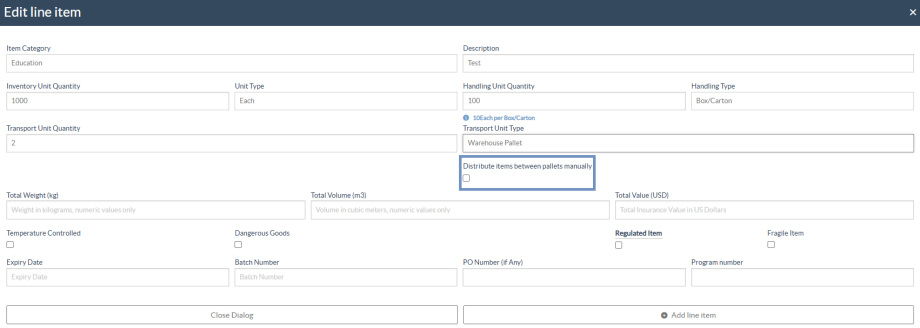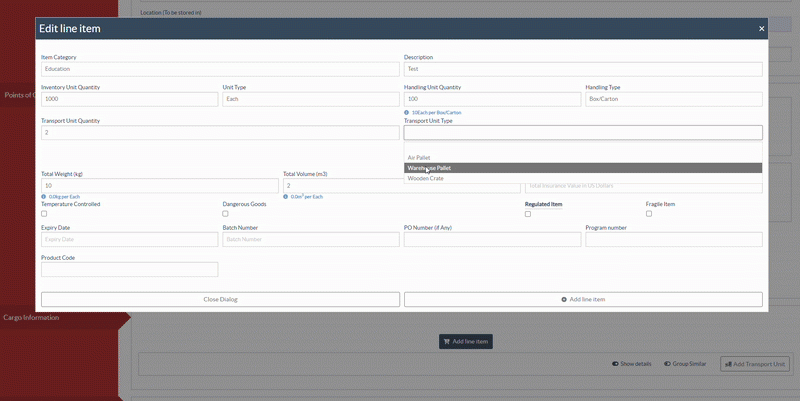Item Category - Users must identify the category of their items using the drop-down menu. The item categories correspond to the Cluster associated with the items, practically which need to be picked based on the use of the line-item cargo. The full list of categories, along with examples, can be seen at the end of this document. The identification of the item categories provides a critical piece of information when reporting Cluster support by sector. A guide on different item categories can be found here.
Description - A full and accurate description of the goods being shipped must be provided in the “Description” section of the SRF. Item descriptions need to be as specific as possible or your SRF may be delayed in processing. The Logistics Cluster needs to know very specific and detailed information on all cargo shipped so that the Cluster can ensure proper handling. Additionally, items such as fuel which may contaminate other humanitarian relief goods such as food need to be shipped in different modes.
Inventory Units - These are the lowest level of units being shipped:
- Quantity - The Total No. of items can only be a whole number and the Unit Type needs to describe the items accurately.
- Unit Type - Right now users can only pick from a drop-down menu of choices in order to ensure standardization of item info from the users. This can easily be expanded if required. Unit choices:
- Each
- Litre
- Pair
- Part
- Bulk (kg)
Handling Units - This section describes how the individually counted units are packed together:
- Quantity - The Total quantity of Handling Units can only be a whole number and the Unit Type needs to describe the items accurately. Please note that the Handling Units Quantity should only be the same or less than the Inventory Units Quantity.
- Unit Type - Right now users can only pick from a drop-down menu of choices in order to ensure standardization of item info from the users. This can easily be expanded if required. Unit choices:
- Bag/Sack
- Bale/Bundle
- Box/Carton
- Crate
- Drum/Barrel
- Kit/Set
- None/Loose
- Roll
Transport Unit (TU) - This section describes how the Handling Units are placed on transport structures such as pallets or crates for movement and storage:
- Quantity - The total number of Transport Units (TUs) can only be a whole number. Each TU represents a distinct container (e.g., pallet or crate) used for transporting grouped Handling Units. Please note that the number of TUs should not exceed the number of Handling Units.
- Unit Type – Users can only select from a pre-defined drop-down list to ensure standardization across the system. These values are defined by the ADM role and cannot be modified by requestors. Unit choices currently available:
- Warehouse Pallet
- Wooden Crate
Distribute Items Between Pallets
A checkbox labeled “Distribute items between pallets manually” appears when a Transport Unit is added.
If Unchecked:
The system will automatically distribute the cargo evenly among the selected pallets.
Example: 1,000 IU / 100 HU across 2 pallets results in:
- Pallet 1 → 500 IU / 50 HU
- Pallet 2 → 500 IU / 50 HU
If Checked:
The user must drag and drop individual Inventory Units (IUs) or Handling Units (HUs) manually across the pallets. This allows for customized packing.
Example: 1,000 items (100 HUs) can be distributed as:
- Pallet 1 → 800 IU / 80 HU
- Pallet 2 → 200 IU / 20 HU
Total Weight and Total Volume - When submitting the weights and volumes of cargo items through the online SRF, it is important that weights and volumes are filled out correctly! The Logistics Cluster uses these dimensions to assess the ability to provide services and plan for activities. More detailed info on calculating cargo dimensions can be found here. An online dimension calculator can be found here.
- Total Kg - The total weight in kilograms (kg) of all inventory units for that line item. Numeric values only.
- Total m3 - The total volume in cubic meters (m3) of all inventory units for that line item. Numeric values only.
Total Value ($) - Total value of each line items on US dollars must be filled. If it is purchased in any other currency then converting the sum into USD can be done.
Temperature Range - Items that are temperature sensitive and may require special storage or handling. To indicate temperature requirement ranges select one of the pre-defined ranges from the drop-down in the SRF. For ranges that are not expressed in the drop-down, please include the temperature ranges in the comments section of the SRF.
| Temperature Range | Common Name |
|---|---|
| +15°C to +25°C | “Controlled ambient” or “Temperature-Controlled” |
| +8°C to +15°C | “Cool” |
| +2°C to +8°C | “Cold” or “Chilled” or “Refrigerated” |
| -25°C to -15°C | “Deep freeze” or “Frozen” |
| different ranges between -80°C to -40°C | "Ultra-low” |
Dangerous Goods - Items which can be considered hazardous or dangerous cargo through international shipping standards. Examples are lithium batteries, items containing fuel or petroleum products, or other chemicals. All such items will have a corresponding UN ID number which can be received once service user start to type the item description or UN ID number. Dangerous Goods UN ID numbers can be looked up using the online DG lookup tool.
Fragile - These are any goods which require sensitive handling or careful storage (e.g. electronics or glass).
Regulated - Items which may have locally implemented restrictions. For example, wireless communications equipment in certain locations where communications equipment is heavily regulated.
Expiration Date - For items that have specific expiration dates that need to be tracked, including food, medical and chemicals. Expiration date is not mandatory, and is generally only included where required.
Batch/Lot Number - For items that must be tracked by batch/lot of production, usually pharmaceuticals, certain types of food or medical consumables. Batch/Lot number is not mandatory, and is generally only included where required.
Comments - This box can provide specific information and/or special requirements for handling or transportation of your cargo/items or any other relevant logistics information.


